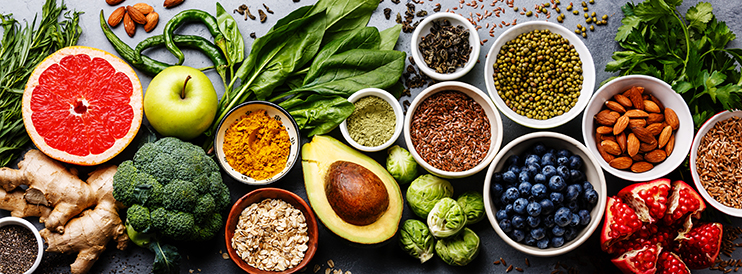Ten superfoods people with diabetes should incorporate in their diet
Nutrition

These foods also can help anyone trying to make smart nutritional choices
Getting through the holidays on a healthy diet is hard for anyone, but it can be especially hard for people with diabetes.
“There are more opportunities to socialize, which always have a food component,” says Aggie Cowan, MS, RD/LD, CDE, dietitian and diabetes education specialist with St. Joseph’s/Candler. “Holiday times also are often high stress with a wide range of emotions. Stress eating and emotional eating can lead to overdoing the sweets and treats that are more easily available during holiday months.”
 Related Article: Surviving the holidays with diabetes
Related Article: Surviving the holidays with diabetes
To help people with diabetes year around, the American Diabetes Association put together a list of 10 superfoods that not only provide essential nutrients and fiber, but they also avoid causing a rapid rise in blood sugar.
Cowan hopes that patients can get excited about replacing refined, low-fiber foods with nutrient-rich superfoods. These include:
1. Beans
Beans are at the top of the list because of their high fiber content, Cowan says. “These include all legumes like pinto, kidney, navy and black beans, as well as black-eyed peas, chick peas, red peas and lentils. The soluble fiber in these beans can slow the rise of the after-meal blood sugar level.”
2. Berries
Strawberries, blueberries and other varieties are filled with vitamins, fiber and antioxidants. Try pairing your favorite berry with fat-free yogurt (which happens to be No. 5 on this list).
3. Citrus fruit
Grapefruit, oranges and tangerines are best in their whole form in order to get the benefits of soluble fiber.
4. Dark green leafy vegetables
Green equals power when it comes to these leafy vegetables. Spinach, kale and collards are very low in carbs and calories and can be eaten plentifully.
5. Fat-free milk and yogurt
By choosing a fat-free diary, you are avoiding saturated fats. Additionally, yogurt is a good source of healthy bacteria, which plays a good role in digestion and nutrient absorption.
6. Fish
Look for fish that are high in omega-3 fatty acids. Examples include: salmon, trout, mackerel, sardines, halibut and tuna. Also, try to choose wild-caught seafood over farm-raised.
7. Nuts
Nuts are a great source of vitamins, protein and healthy fat, which can help keep you feeling full longer and slow the absorption of glucose. Nuts, however, are high in calories, so try limiting yourself to a handful a day, and avoid nuts packaged or roasted in oil.
8. Sweet potatoes
The American Diabetes Association says that sweet potatoes have a lower glycemic index, or GI, than regular potatoes. A food’s GI is a measure of the effects of that food on blood sugar levels.
9. Tomatoes
However you like them – raw, pureed or in a sauce – these plump veggies provide vitamins and iron no matter how they are prepared.
10. Whole grains
Whole grains are high in fiber and nutrients and support healthy digestion. Try choosing whole grain rice and bread over white rice and bread. Also consider grains you might not think to include in your diet such as quinoa, millet, faro, barley and lentils. When shopping for grains, be sure to read the ingredients. If it says enriched, bleached or even unbleached, then they have processed out the healthy components.
Related Article: Here’s why you shouldn’t always trust the front of the food package you buy
Cowan says someone who is dealing with diabetes, or really anyone who wants to make smart nutritional choices, should consider these superfoods the next time they are in the grocery store. She believes that including these foods in your meal plan does not have to be too costly if you are able to purchase fruits and vegetables in season, while items like beans are often inexpensive year around.
“The take away from this list is that a carbohydrate-based diet is healthiest when you include high nutrient, high fiber whole foods on a regular basis, especially when you use them to replace less healthy, refined carbohydrates.”